
Is Coronavirus Airborne?
One of the most critical questions of the coronavirus pandemic seems straightforward: Can I catch it from just breathing the air? Initially, many experts said no, believing instead that transmission required a cough or sneeze to spread virus-laden respiratory droplets.
However, after 45 of 60 people who attended a choir practice in March in Washington state became infected and two died—despite no one showing symptoms, hugging, or shaking hands at the time—it began to seem likely that the virus could spread through aerosols, which are microscopic particles that are much smaller than droplets and can hang longer in the air.
That incident and continued outbreaks in long-term care facilities have led some experts to reconsider their thinking on how Covid-19 may spread.
The Centers for Disease Control and Prevention (CDC), acknowledging that even people who don’t have symptoms can spread the disease, changed their face mask recommendation in early April. They are now asking everyone to wear cloth face masks in public places like grocery stores and pharmacies, where it’s difficult to maintain the recommended “social distance” gap of 6 feet or more.
Here’s what’s known today about how the novel coronavirus spreads in the air and how you can protect yourself.
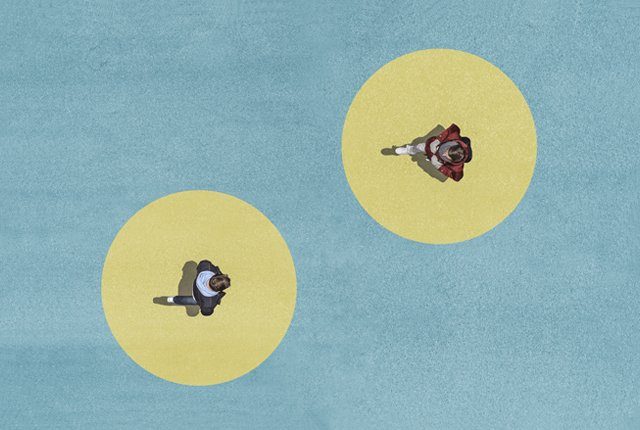
Droplets vs. aerosols
Simply put, droplets, though still very small, are much larger than aerosols. Droplets are heavier—they’re what you can feel come out when you cough or sneeze. Because of gravity, they fall out of the air, onto surfaces, faster. They can fly as far as several feet from your nose or mouth.
The main debate has been whether the virus spreads through droplets alone or also by aerosols, which is basically “exhaled air,” says epidemiology expert Philip Bretsky, MD, MPH, PhD, an internist at Santa Monica Primary Care. We do know for certain that the novel coronavirus is spread by respiratory droplets, he says, so at a minimum, covering coughs and sneezing into our elbows is extremely important.
The CDC so far doesn’t address potential airborne transmission—which means via aerosols—focusing instead on droplets. However, a late March report in the New England Journal of Medicine found that the new virus, SARS-CoV-2, can live in aerosols for up to three hours.
Expert opinions vary on how likely it is that viruses that are airborne can actually cause an infection. Emily Gurley, PhD, MPH, an epidemiologist at Johns Hopkins, says the virus generally doesn’t hang in the air waiting to infect people. “The virus is not airborne, except, perhaps, in healthcare settings where patients are undergoing some kind of procedure where the virus is aerosolized,” she says.
Dr. Bretsky agrees that the jury is still out, but he believes we should err on the side of caution. “Evidence for aerosol spread is mixed, but from a public health standpoint, it is safest to assume that some infection may also occur by this route,” he says. He points to an article by Dr. Nancy Leung from the Hong Kong School of Public Health published in Nature Medicine, showing coronavirus detected in the exhaled breath and coughs of children and adults with acute illness. “Their ability to detect [the virus in exhaled breath] decreased significantly with the use of surgical face masks,” he noted. “So as with other caution-driven interventions, I think it is safest to assume that aerosol spread is a possibility until proven otherwise.”

Can I get coronavirus from someone breathing heavily or exhaling as they run by?
With much of the country under stay-at-home or shelter-in-place orders to try to slow the virus’s spread, stir-crazy people are often heading outdoors, going on walks, runs, and hikes wherever possible. Although that afternoon jaunt might be mentally and physically energizing for the person taking it, the question remains: Could they, by exhaling or heavily breathing, spread the virus to you as they pass by?
Georgine Nanos, MD, MPH, a board-certified family physician specializing in epidemiology and chief executive officer of Kind Health Group, in Encinitas, California, believes it’s possible. If someone carrying the virus coughs, sneezes, has a runny nose, or breathes heavily, he or she can exhale droplets that could land on a surface that you touch, she says. Then if you touch your face, you could become infected. “The concern,” she says, “is that there are many asymptomatic carriers or people in the early stages of infection, who don’t have any symptoms and may be spreading the disease.”
Dr. Bretsky agrees it could happen, maybe. “I think that acquiring the virus from an exhale or heavy breathing, particularly outdoors—like a runner running past you—is unlikely, but it could happen in the right combination of circumstances,” he says.
For context, Dr. Bretsky compares what we know about Covid-19 with other infectious diseases. One metric that scientists use to calculate how contagious an illness might be is R0 (pronounced R naught), or the number representing the average number of people that an infected person will make sick during the duration of their illness.
For comparison, he says, measles, which is known to be airborne, is the most infectious, with an R0 between 12 and 18. Influenza, which is believed to spread mostly through respiratory droplets, is two to three. Covid-19 has been estimated between 1.5 and 3.5.
Ultimately, the uncertainty over whether the virus spreads through the air makes it difficult to draw conclusions, but the possibility that it does means people need to take precautions.
(Here are answers to your other quirky questions about coronavirus.)
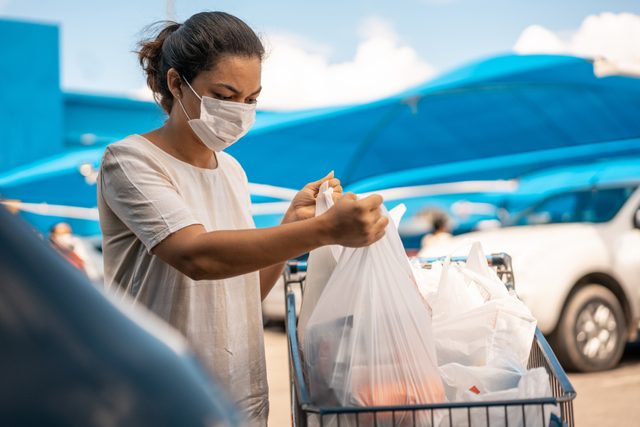
Is aerosolized spread more likely indoors?
Despite shelter-in-place orders and food delivery services, people still may have to venture to the grocery store, pharmacy, or doctor’s office (or to work, if they are an essential worker). In those indoor cases, are you more likely to be infected with the virus?
Dr. Nanos reiterated current thinking: “Spreading of the Covid-19 virus is more likely to happen indoors but this virus is not technically considered airborne at this point in time.”
Lisa Brosseau, ScD, a retired professor from the University of Illinois at Chicago and an expert in respiratory protection, offers a little more detail on how a person gets infected. “It isn’t just one virus particle,” she says. “You have to get a certain number of virus particles in your lungs—or in contact with whatever cells it’s aiming at in your respiratory system—and those have to be infected, and you need enough infection that it overwhelms your defenses. The greater the dose, the more likely there is that you will get an infection.”
Dr. Brosseau, who’s also an expert in workplace exposure to infectious aerosols, explains that time and concentration are both important factors, with greater doses either coming in spaces with a lot of people, many of whom are infected, or in an infected space for a long period of time. “Why EMTs and healthcare workers and grocery workers are getting infected is because they are getting an infectious dose and the nature of their job puts them into contact with an infectious dose because of time and concentrations,” she says.
Because many indoor spaces are more confined, it’s theoretically possible that they could lead to a greater concentration of virus particles.
Dr. Bretsky agrees. “Indoor meetings probably aren’t a great idea, whereas increasing ventilation and not recirculating unfiltered air may help,” he says. “Again, this is where masks are helpful, as they allow a degree of two-way protection.”
(Here’s how to safely shop for groceries during the pandemic.)
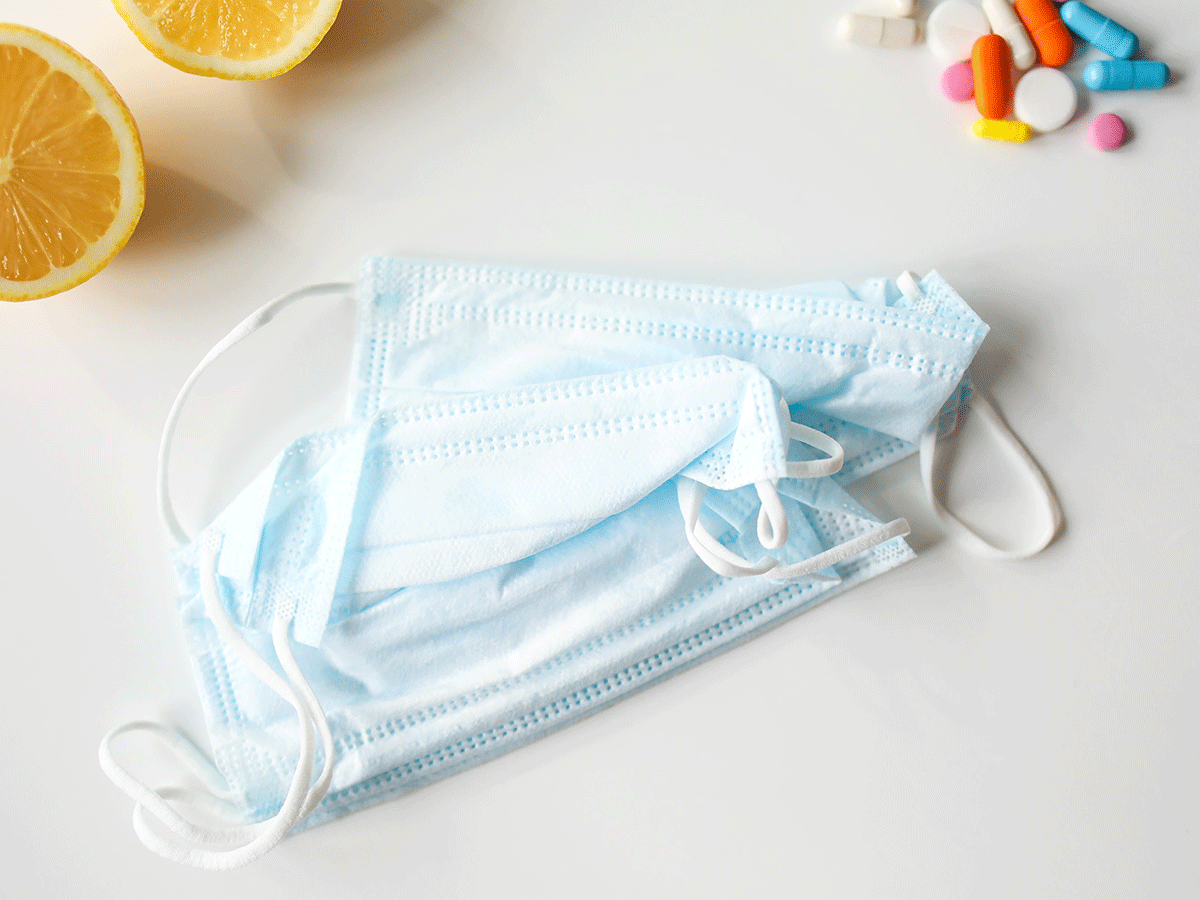
Would I have to inhale coronavirus or could it land in my eyes and infect me?
Official guidance on how to protect against coronavirus involves not touching the eyes, as well as the mouth and nose. However, it’s not known for certain whether the eyes are a source of infection.
“Are the eyes a portal? We don’t know yet with SARS-CoV-2,” says Dr. Brosseau, using the full medical name for the virus that causes Covid-19. “I’ve looked, I haven’t seen any data yet. We do know that the eyes are a portal for infection for influenza, and that has been demonstrated. … Eyes are somewhat connected to the respiratory system, so it’s not a surprise that you could get infected via the eyes, but I don’t know.”
Similarly, the American Academy of Ophthalmology (AAO) sees the potential for transmission via the eye, but stops short of confirming it: “Several published reports and a recent news article suggest that SARS-CoV-2 can cause conjunctivitis, either as an early sign of infection, or during hospitalization for severe Covid-19 disease.” So it’s possible that Covid-19 is transmitted to the conjunctiva, the membrane that covers the front of the eye and the inside of the eyelids, through the air or by hand-to-eye contact. (Here are the ways you’re washing your hands wrong.)
Dr. Bretsky believes so too. “There is evidence that the virus can be acquired via the conjunctiva of the eye,” he says. “It makes sense … given that the tear ducts drain into the nose, which is why your nose runs when you cry.”
“Also,” he says, “we have a tendency to touch or rub our eyes with our hands and, similarly, Covid-19 on the hands or fingers could then be spread into the eye.” Healthcare workers wear face shields or goggles to protect against this potential means of transmission, he notes.
The lack of clear answers, continuing uncertainty, and the potential for infection reinforce the importance of the protective measures that we know are effective.
“This is the importance of social distancing, to avoid close contact that would enable someone to get infectious droplets close enough to your face,” Dr. Nanos says. “But,” she adds, “it’s critical to be engaging in all the prevention measures at once. If you touch a contaminated surface and then touch your face, that’s a more likely way to contract the disease.”
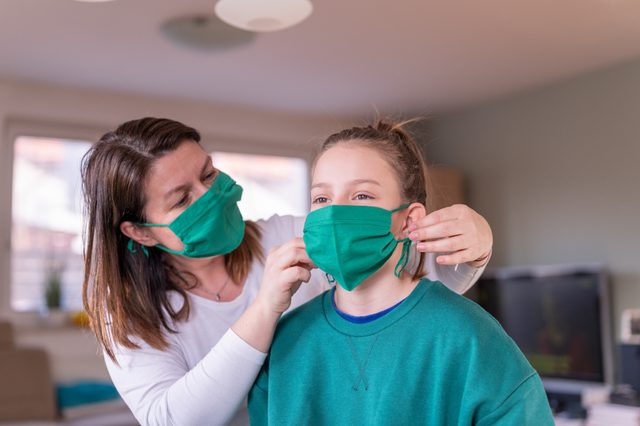
Do cloth masks protect enough against airborne viruses?
After months of saying the opposite, the CDC recently made an about-face on its stance that the general public shouldn’t wear masks. The new policy states: “CDC recommends wearing cloth face coverings in public settings where other social distancing measures are difficult to maintain (e.g., grocery stores and pharmacies) especially in areas of significant community-based transmission.”
With medical masks in short supply—and best left to medical professionals who are grappling with personal protective equipment shortages, in any case—many people have started making face masks, often relying on cloth face coverings. (Here’s how to make a coronavirus face mask.) It begs the question, however: Are cloth masks enough protection against coronavirus?
Dr. Brosseau’s opinion is no. “Cloth masks are no protection whatsoever,” she says. “They have very poor filtration capabilities, and I don’t think that large droplets are the primary mode of transmission. So they might capture larger droplets when you sneeze or cough, but we have a lot of asymptomatic transmission—which is breathing and talking, which generates smaller particles.”
The filtration isn’t good enough on cloth masks, she says, adding that a cloth mask would be protective only if you wore so many layers you couldn’t breathe through it—in which case, you’d be likely to take it off.
Dr. Nanos agrees somewhat, but says cloth face coverings do have some value. “You can still catch Covid-19 if you’re wearing a mask,” she says. “The mask is one way for individuals to prevent spreading the disease to others. By itself, it is not necessarily the best way to prevent getting Covid-19, but it is a way to protect others from you if you have asymptomatic disease—meaning you have the virus but have no symptoms.
“All our prevention measures need to be done in combination with each other to effectively flatten the curve,” she says: handwashing, disinfecting your cell phone, social distancing, not touching your face.
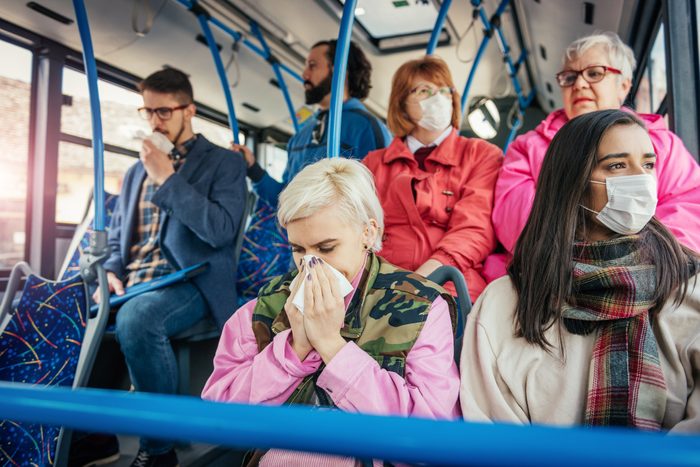
Is six feet far enough for social distancing?
Research published in the CDC’s Emerging Infectious Diseases Journal showed that Covid-19 in two hospital wards in Wuhan, China spread up to four metres (about 13 feet) from patients, provoking the question: With coronavirus potentially aerosolized, and face coverings probably providing minimal protection, is the six-foot social distancing guideline enough?
Gurley, the Johns Hopkins epidemiologist, believes so, citing her earlier point that coronavirus is not suspended in the air for long periods. “This is why keeping a six-foot distance from someone else should protect you from infection—because the droplets will fall out of the air within six feet.”
However, Dr. Brosseau is skeptical. “The purpose is in healthcare to suggest that people stand six feet away in a patient’s room and you wouldn’t be exposed to droplets that people generate—that’s already been proven to be wrong: Coughs and sneezes can go farther.
“The translation of a six-foot rule that doesn’t work in healthcare has no relevance in public. Being six feet away is better than being one foot away…but if you think you aren’t going to get any transmission at six feet, that’s wishful thinking.”
In fact, Dr. Bretsky notes, MIT simulations have shown that exhalation from coughs or sneezes could reach up to eight metres, or approximately 27 feet. “The idea of two metres comes from the supposition that coronavirus is primarily spread by larger droplets—from a cough or a sneeze,” he says. “Gravity acts on these droplets and by two metres, these larger and more infectious droplets will drop to the ground. But the idea that these hit some sort of wall and stop is, obviously, not true.
“The question remains whether or not the particles remaining at 27 feet are of sufficient viability and dose to cause infection. I would argue, and think that most would agree, that your likelihood of infection acquisition is greater at one foot from a sneeze than at 27 feet.”
With differing opinions based on varied research, and effective N95 masks rightfully reserved for healthcare professionals, it’s clear that sheltering-in-place and avoiding unnecessary excursions or contact with other people remain important forms of protection.
(Here are the best food delivery services in Canada, so you don’t have to leave your house to pick up groceries.)
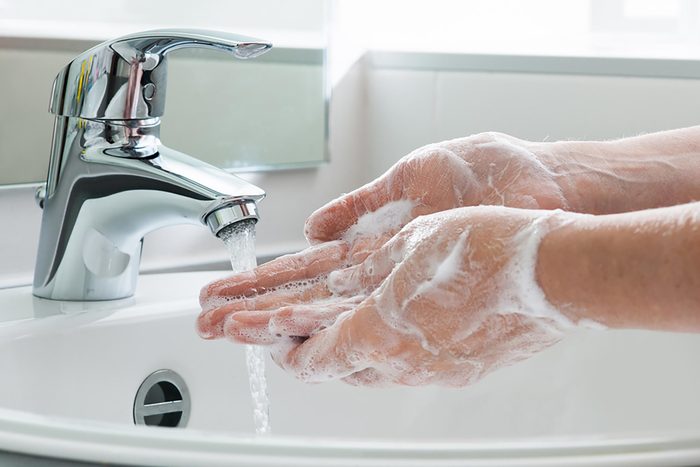
The need to stay vigilant
As some states like California and Oregon start to flatten the curve thanks to early vigilance, the question on most people’s minds is, when can we get back to “normal”? Experts agree that it needs to be approached with caution.
“If people stop social distancing because they feel they are safe with masks on, we will see the infection numbers start to increase dramatically,” says Dr. Nanos. “This is a very dangerous practice which will give people a false of security. Everyone has to be practicing all the preventive measures in combination with each other at the same time in order to reduce the spread of Covid-19.”
Dr. Brosseau is similarly wary. “I’m not an epidemiologist so can’t give all the details, but what I do know is even if we open up, if we don’t have a vaccine and lot of testing—either of which we do not have at this moment—we will get more transmission as people go out and interact, especially since we have asymptomatic people.
“We will have more illness, more cases, more deaths, and we will get a surge again, it is very likely. What it will look like, we don’t know—but hopefully we will have some lessons this time around so next time around it won’t be as bad.”
Dr. Bretsky puts it into perspective, citing his faculty adviser at Yale, renowned virologist Dr. Robert Shope, an early and leading voice in warning of emerging infectious disease through the 1992 publication of Emerging Infections: Microbial Threats to Health in the United States.
“At a 1995 U.S. Senate hearing, he stated, ‘We should not expect a quick fix to the continued emergence of infectious diseases,'” says Dr. Bretsky, discussing the importance of early detection and continued research. “Perhaps his most memorable quote is as follows: ‘The medical community and society at large have tended to view acute infectious diseases as a problem of the past. But that assumption is wrong. We claimed victory too soon,'” recalls Dr. Bretsky. “Words from 1992.”
Next, learn if you should be wearing gloves to protect against coronavirus.
